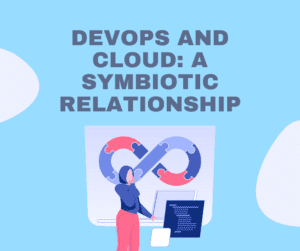| Heading | Subheading |
|---|---|
| I. Introduction | |
| Definition of DvOps and cloud computing | |
| Importance of DvOps and cloud computing | |
| Overview of the relationship between DevOps and cloud computing | |
| II. Understanding DevOps | |
| Definition of DevOps | |
| Principles of DevOps | |
| Benefits of DevOps | |
| III. Understanding Cloud Computing | |
| Definition of cloud computing | |
| Types of cloud computing | |
| Benefits of cloud computing | |
| IV. The Symbiotic Relationship between DevOps and Cloud Computing | |
| How DevOps and cloud computing work together | |
| Benefits of integrating DevOps and cloud computing | |
| Use cases for DevOps and cloud computing | |
| V. Best Practices for Implementing DevOps and Cloud Computing | |
| Strategies for successful integration of DvOps and cloud computing | |
| Tools and technologies for DvOps and cloud computing | |
| Challenges and how to overcome them | |
| VI. Case Studies | |
| Real-world examples of successful DvOps and cloud computing implementations | |
| Lessons learned from case studies | |
| VII. Conclusion | |
| Recap of the importance of DvOps and cloud computing | |
| Future outlook of DvOps and cloud computing | |
| VIII. FAQs | |
| What is the difference between DvOps and cloud computing? | |
| How does DevOps improve cloud computing? | |
| What are the benefits of integrating DevOps and cloud computing? | |
| What are the challenges of implementing DevOps and cloud computing? | |
| What are some tools for DvOps and cloud computing? |
DevOps and Cloud: A Symbiotic Relationship
Cloud computing and DevOps are increasingly being used by businesses to streamline processes and improve efficiency as technology advances. It enhances the speed of the network that runs a lot of functions in 1 platform.
DevOps emphasizes collaboration, communication, and integration between development and expert operations teams in software development. In contrast, cloud computing involves delivering services via the internet, including storage, servers, databases, software, and much more.

Understanding DevOps
DevOps is a methodology that seeks to bridge the gap between admin, host, development, and operations teams by promoting communication, collaboration, and automation. The core principles of DevOps include continuous integration, delivery, and deployment. By adopting these principles, organizations can improve their software development processes, reduce errors, and increase their speed to market.
Understanding Cloud Computing
Cloud computing: Public, private, and hybrid clouds are the three main types of cloud computing. Cloud computing provides on-demand internet access to servers, storage, databases, and software via the internet. Public & private cloud services are offered by some popular third-party providers, including Amazon (AWS), ZDNet, Microsoft Azure, and Google Cloud Platform (GCP). In hybrid cloud services, public and private cloud services are combined on the organization’s infrastructure.
The Symbiotic Relationship between DevOps and Cloud Computing
DevOps and cloud computing work symbiotically, each supporting and enhancing the other. Cloud computing provides the infrastructure and resources necessary for DevOps teams to develop, test, and deploy software quickly and efficiently. At the same time, DevOps practices such as continuous integration and continuous delivery enable organizations to take full advantage of the scalability, flexibility, and agility of cloud computing.
Best Practices for Implementing DvOps and Cloud Computing
Organizations must adopt some best practices to integrate DevOps and cloud computing successfully. These include establishing an evident DevOps culture, implementing automation tools, and prioritizing security and compliance. It is also essential to choose the right cloud computing services and providers and to design resilient, scalable, and highly available systems.
Streamlined Collaboration and Communication
DevOps, the amalgamation of Development and Operations, emphasizes close collaboration between these traditionally siloed departments. The Cloud provides the ideal platform for fostering this collaboration, offering shared repositories, real-time communication tools, and centralized documentation. By enabling developers, testers, and operations teams to work cohesively on the same infrastructure, the Cloud breaks down communication barriers, reducing misunderstandings and accelerating the development lifecycle.
Accelerated Delivery Cycles
In the competitive digital landscape, speed is of the essence. DevOps practices coupled with Cloud infrastructure facilitate Continuous Integration (CI) and Continuous Deployment (CD), allowing teams to automate and streamline the software delivery pipeline. This results in shorter release cycles, reduced manual intervention, and faster response to market demands. The Cloud’s scalability ensures that applications can be deployed and scaled swiftly, accommodating fluctuating workloads seamlessly.
Enhanced Scalability and Flexibility
Traditional on-premises infrastructure often struggled to handle sudden spikes in user activity. Cloud computing eliminates this hurdle by offering on-demand scalability. DevOps practices complement this by enabling automatic scaling and load balancing, ensuring optimal performance under varying workloads. Businesses can provision resources precisely when needed, avoiding over-provisioning and minimizing costs.
Cost Efficiency
DevOps and Cloud combine to create an environment of cost efficiency. With automation at the core of DevOps, repetitive manual tasks are minimized, allowing teams to focus on value-added activities. Cloud services operate on a pay-as-you-go model, reducing the need for upfront capital investment in hardware and infrastructure. This model aligns well with DevOps principles of optimizing resource utilization and delivering incremental value.
Robust Disaster Recovery and High Availability
Ensuring business continuity is a top priority, and here again, the partnership of DevOps and Cloud shines. Cloud platforms offer built-in disaster recovery mechanisms, making data replication, backups, and failover setups easier to implement. DevOps practices enable the creation of well-documented, version-controlled infrastructure, simplifying recovery processes in case of failures. High availability and fault tolerance become achievable without the complexity of traditional setups.
Focus on Innovation
By automating routine tasks and minimizing manual interventions, DevOps frees up valuable time and resources for innovation. Cloud services provide a plethora of tools and services that enable experimentation and rapid development of new features. The synergy between DevOps and Cloud empowers teams to iterate quickly, gather user feedback, and refine products iteratively, fostering a culture of continuous improvement and innovation.
Security and Compliance
Security concerns have often been cited as a barrier to Cloud adoption. However, modern Cloud providers offer robust security features, including encryption, identity and access management, and compliance certifications. DevOps practices further enhance security by promoting the automation of security controls and audits, ensuring that security measures are consistently applied throughout the development lifecycle.
- Agility and Speed: Cloud services provide the infrastructure needed to quickly set up and tear down development and test environments. This aligns with DevOps principles of automation and continuous delivery, enabling rapid and frequent releases.
- Scalability: Cloud platforms offer auto-scaling capabilities that align with the dynamic nature of modern applications. DevOps practices ensure that the application code and infrastructure can handle these automatic scaling events seamlessly.
- Collaboration and Communication: DevOps encourages cross-functional collaboration, and the cloud provides a common platform where teams can access shared resources, tools, and data. This fosters real-time communication and reduces bottlenecks.
- Resource Efficiency: Cloud services allow organizations to provision resources as needed, avoiding over-provisioning and underutilization. DevOps practices complement this by optimizing resource usage through automation and monitoring.
- Feedback Loop: Cloud environments provide rich monitoring and logging capabilities, which are vital for DevOps teams to gather feedback on application performance. This data informs continuous improvement efforts.

Case Studies
There are many real-world examples of successful DvOps and cloud computing implementations. For example, Netflix has used a combination of DvOps and cloud computing to revolutionize how we consume content. The company has implemented a microservices architecture that allows it to scale its infrastructure dynamically in response to changes in demand. Another example is Amazon, which has leveraged DevOps and cloud computing to improve its internal processes and accelerate innovation. By adopting a DevOps culture and using AWS services, Amazon has reduced the time it takes to deploy new features and improve efficiency.
Conclusion
DvOps and cloud computing are two powerful technologies transforming how organizations operate. By working together, they offer a range of benefits, including faster time to market, improved efficiency, and greater scalability. However, integrating DvOps and cloud computing requires careful planning and a commitment to best practices. Organizations that successfully implement these technologies can gain a significant competitive advantage and position themselves for success in the digital age.
FAQs
- What is the difference between DevOps and cloud computing? DveOps is a software development methodology emphasizing collaboration, communication, and integration between development and operations teams. At the same time, cloud computing is a delivery model for computing services that provide on-demand access to resources over the internet.
- How does DevOps improve cloud computing? DevOps improves cloud computing by promoting communication, collaboration, and automation between development and operations teams, enabling organizations to take full advantage of the scalability, flexibility, and agility of cloud computing.
- What are the benefits of integrating DevOps and cloud computing? Integrating DevOps and cloud computing offers a range of benefits, including faster time to market, improved efficiency, greater scalability, and increased innovation.
- What are the challenges of implementing DevOps and cloud computing? Challenges of implementing DvOps and cloud computing include establishing an evident DevOps culture, implementing automation tools, prioritizing security and compliance, choosing the right cloud computing services and providers, and designing resilient, scalable, and highly available systems.
- What are some tools for DevOps and cloud computing? Some tools for DvOps and cloud computing include AWS, Microsoft Azure, Google Cloud Platform, Jenkins, Docker, Kubernetes, and Terraform.
